Full of Sound and Fury, Signifying Nothing
A definitive examination of the atrocity that is Three Billboards
Posted 22 Sep 2018
Content warning. This film deals with sensitive topics including rape, assault, suicide, sexism, hate crime, terminal illness, and racism. As such, so does this essay. Read on at your discretion.
This essay also contains spoilers, but you shouldn’t care about that, because seriously, you shouldn’t watch this film.

Introduction
Three Billboards Outside Ebbing Missouri was one of the most highly-acclaimed films of 2017. It holds an aggregate rating of 92% on Rotten Tomatoes, where one critic is quoted describing it as “one of those great films that never strikes a false note.”
Did he watch a different film than I did? The Three Billboards I watched was essentially a couple good notes drowned entirely out by a cacaphony of bad ones.
I hardly even know what to make of the overwhelming critical consensus on this film. Is mainstream criticism so insulated that it can’t criticize something that has a veneer of intelligence? Is most high-profile cinema so poorly-made that a modicum of “seriousness” is all it takes to for a film to stand out from the crowd? In either case, it reflects poorly on the Hollywood establishment here in America.
I’m not the first person to call out the film’s shortcomings, but it irritated me enough that I feel compelled to write my own take. From its unbelievably superficial understanding of social issues to its ridiculous plot conveniences, this film is so loaded with problems that it’s hard to even know where to begin.
So let’s kick things off with a brief discussion of what I didn’t hate about this film.
Credit where it’s due
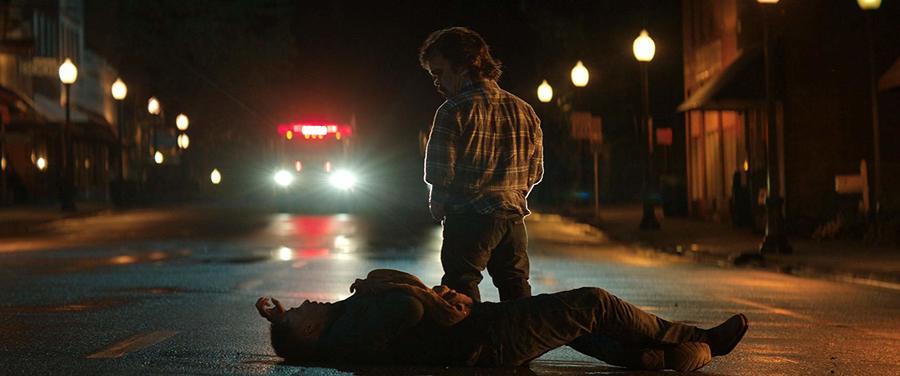
On the most superficial level, there’s nothing wrong with this film. In fact, in terms of photography it does quite well. There are some beautifully-framed shots, and it hasn’t been color-graded to the point of being monochromatic like so many other films these days. The camera work is mostly smooth and steady, in contrast to the widespread scourge of shaky hand-held footage.*
* Sorry about that. I will try to keep my curmudgeonly opinions about contemporary filmmaking as a whole to a minimum past this point.
Much has been made of the acting in the film, and indeed most of the cast excels, despite the material. Frances McDormand in particular does a bang-up job portraying Mildred, and none of that character’s flaws are her fault. Clearly the actors here believed in the script and gave it their all.
Carter Burwell’s score is good too, a skillful blend of cinematic drama and small-town instrumentation. The use of the aria “Last Rose of Summer” (from the opera Martha by Friedrich von Flotow) is a great example of obscure, pre-existing music being incorporated into a film to great effect.
Finally, some of the scenes are genuinely excellent: intense, gripping, and memorable. It’s unfortunate that they couldn’t have occurred in a film that deserved them.
The Awful Characters
Stories largely succeed or fail on the strength of their characters, and this is certainly the case with Three Billboards. What drags down the film more than practically any other aspect of it is the fact that its characters are just horrible. Not only are most of them are genuinely awful people by any objective measure, they’re extremely uneven to boot.
I’m not familiar with director and writer Martin McDonagh’s other work, but going by this script alone one gets the impression that he has no idea how to construct a complex character. The characters of Three Billboards are painted in extremely broad strokes and they fluctuate wildly depending on the whims of the plot. Worst of all, McDonagh seems to conflate “contradictory” with “complex.” Contradiction is an element of complex characterization, but all by itself it’s meaningless and artificial.
Mildred

Let’s start with Mildred. Since she’s our ostensible hero and protagonist, the film depends on her character’s functionality. As I said already, Frances McDormand acts the hell out of the part, but there are elements of this character that are so awful that a good performance just can’t save it.
At the outset, Mildred is a relatable character. She is a grieving mother with a clear motivation: she wants justice. There is no reason that this couldn’t work. The problem is that the things Mildred does over the course of the film are so heinous that she becomes more of an anti-hero: past a certain point I just didn’t feel comfortable rooting for her anymore. I can empathize with a person who confronts a corrupt police establishment with a propaganda campaign, but not with a person who physically assaults teenagers when they don’t confess to petty vandalism. In her most horrifying moment, she decides to firebomb the police station, which is pretty much guaranteed to hurt someone, regardless of whether the building is empty. (She wrongly believes that it is, but the point is that arson has the potential to cause harm far beyond wherever the fire starts.) Mildred starts out as someone who acts out due to deep mental anguish, but eventually she just starts to seem like a cruel psychopath who is more interested in inflicting pain upon her perceived enemies than she is in seeking justice.
But don’t worry! McDonagh makes sure to make her into a complex character by throwing in some bizarre and gratuitous scenes that contradict her usual personality. She can’t be a heartless monster if she says nice things to deer! She must still have a sense of humor if she narrates dialogue for her pink bunny slippers in funny voices! These scenes make little to no sense in the context of the rest of the movie; and all I can guess is that they were shoehorned-in as a desperate attempt to keep the audience from turning against Mildred entirely.
Dixon
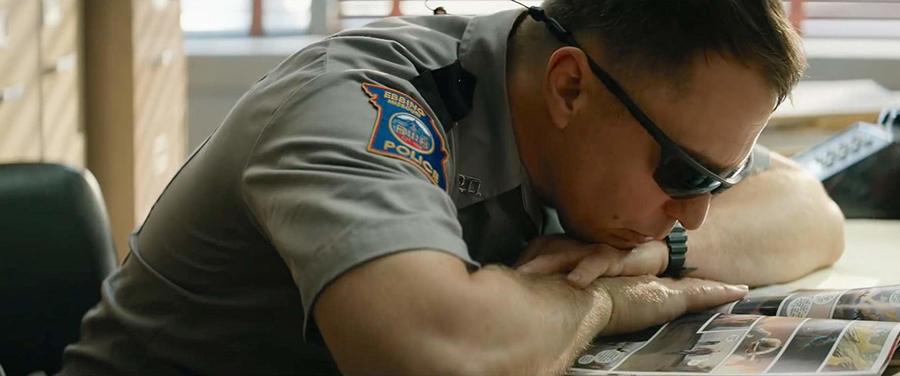
Officer Jason Dixon has essentially the same character problems Mildred has, but ratchets them up to an even greater extreme. What makes Dixon even more problematic than Mildred is that despite his objectively awful behavior, the film explicitly tells the audience that he’s an okay guy.
Dixon’s primary defender is Chief Willoughby, who for some reason is convinced that Dixon is a “good man,” in the face of all evidence to the contrary. “He tortured a man in custody!” objects a fellow officer near the beginning of the film, but Willoughby doesn’t believe it.
Exactly what Willoughby sees in Dixon is unclear; prior to Willoughby’s death we never see him do anything that isn’t either cruel or incompetent. It’s frequently implied that his cruelty specifically targets Black people, to the point where even Willoughby concedes that Dixon is “vaguely racist.” (The film’s criminally superficial depiction of racially-motivated police brutality will be discussed later.) In one of the film’s most brutal scenes (a scene which, in a different context, could have been great), Dixon attacks the ad agent responsible for the billboards, throwing him out a second-story window and beating him to a pulp afterward. He also punches the agency’s receptionist in the face for the sake of completeness. None of this is out of character for him, especially in the context of the fact that he is essentially the main antagonist for the first half of the film. The problem is that he is, by any objective measure, a really awful person. This “decent man” that Willoughby sees is not in evidence.
But Willoughby is a prophet, apparently, because all it takes to completely reform Dixon is a gentle letter and a few third-degree burns. I have never seen such a ridiculous character reversal in my life. Dixon goes from being a violent and incompetent monster in the first half to being a determined, compassionate gumshoe in the second. One might expect that Old Dixon would have killed Mildred in a violent, Ahab-esque rage following the arson incident, but luckily for Mildred, New Dixon instead decides (while the fire is still raging) that he will now be her staunchest ally. That the catalyst for this change is a literal “purifying flame” makes it that much worse; I can’t watch it without imagining McDonagh congratulating himself for writing Dixon as a phoenix, renewing itself by fire.
And of course, Dixon also has the hallmarks of complexity-via-contradiction. In addition to being a violent psychopath, he’s also a childish naïf who lives with his mother, reads comic books (comics are always childish in the oh-so-mature world of Hollywood), and collects toys. Also, despite his predilection for roughing up Black people, he’s against killing gays! How about that! And in the only scene in which he’s allowed to show an emotion other than murderous rage, he breaks down in tears following Willoughby’s suicide. One would be forgiven for thinking that the only reason he’s upset by this is that he has lost the only person willing to give him the benefit of the doubt.
Dixon is one of the most poorly constructed characters I’ve ever seen in a film, and would have been a lead weight in any script. In Three Billboards, he could very well be the primary element that turned the movie from being mediocre to being infuriating.
The Suspect
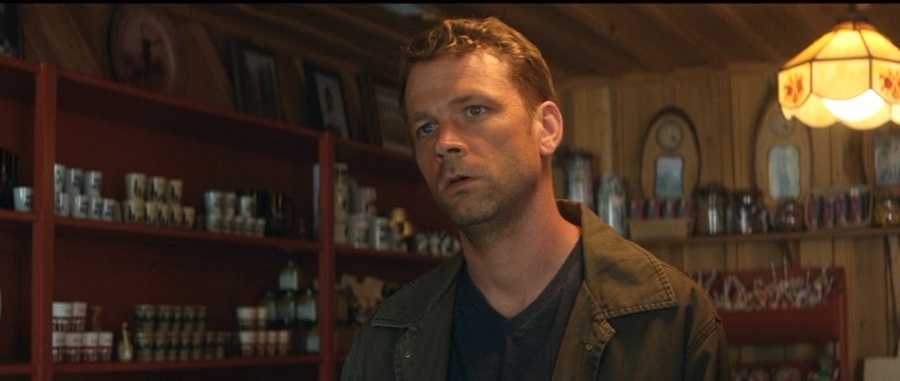
Slightly past the halfway point of the film, we are introduced to a new character. This guy is never named in the film (IMDB identifies him as “crop-haired guy”), but nevertheless he is going to take over the position of Primary Villain for the remainder of the film. From here on I will refer to him as The Suspect, since he is never actually convicted of any wrongdoing.
But don’t worry about that, because The Suspect is definitely a very bad man. And how do you create a very bad man in a film where our ostensible protagonists are both guilty of assault? Well, you just make him have the nerve to brag about assaulting people.
In The Suspect’s first scene, he goes into the gift shop where Mildred works with the express purpose of intimidating her. He insinuates that he was responsible for the murder of Mildred’s daughter, then admits that he actually wasn’t. But, he hastens to add, he “would’ve liked to.” He smirks, then exits. We later learn that he comes from Idaho, and only knows about the situation from the TV and radio. For context: driving from Idaho to Missouri is at least a thirteen hour trip. So either Mildred’s case has made national news by this point, and inspired the guy to drive half a day just to intimidate a grieving mother; or he was passing through Missouri for some other reason and decided to harass someone he saw mentioned by the local news. Either way, he apparently took the trouble to figure out where Mildred works, and staked out the place until she was alone.
Why would he do this? Simple: in order to look bad when compared to the protagonists, our new villain needs to be the very incarnation of evil. I was tempted to refer to him as a Disney villain, but honestly most Disney villains are more complex than this psychopath. He never appears onscreen without insinuating that he’s a serial killer and rapist, and has no discernable motivation. I’m having trouble even coming up with similar characters to compare him to. Usually characters who are this unabashedly evil appear as comedic foils in stories that are meant to be goofy.
Penelope
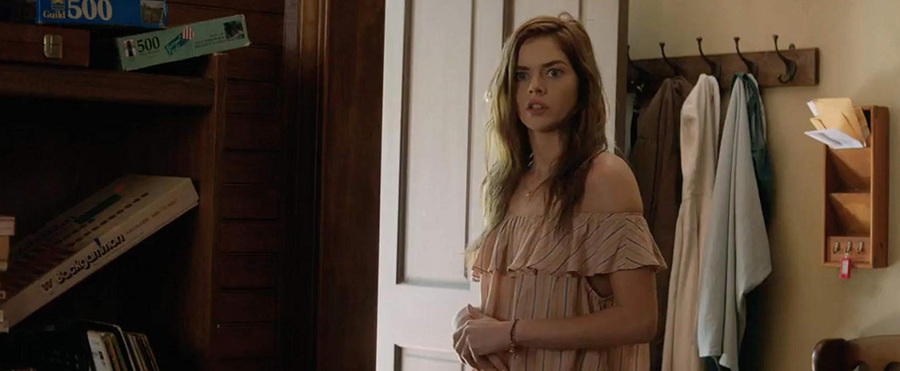
Much of the hype around Three Billboards points out that the film is centered around a strong female character, Mildred. This is all well and good; it’s a well-known fact that Hollywood is deficient in this department. I wouldn’t be too hasty to chalk this film up as a win for feminism, though, because the female characters who aren’t named Mildred are mostly depicted as gibbering airheads.
The most egregious example of this is Penelope, the 19-year-old girlfriend of Mildred’s ex-husband, Charlie. In one of the first scenes she appears in, she stumbles into the middle of a violent altercation between Mildred and Charlie. Does she scream? Does she rush in and try to protect her partner? Does she back out of the room and hope no one saw her? No, of course not. She babbles inanely about how she needs to use the bathroom, but doesn’t want to interrupt anything. She is concerned that she might be interrupting a knife fight. Clearly the moment is meant as comic relief, but comic relief can take infinite forms. I don’t think, in the 21st century, that we should still be seeing characters who can be entirely summed up as “dumb blonde.” (She’s equally idiotic her other big scene, in which she can’t remember the difference between polo and polio.)
Oh, but Penelope isn’t just an idiot. The film also sees fit to paint her as a reprehensible floozy. She is always dressed in revealing, flirty clothing, a stark contrast to no-nonsense Mildred’s ever-present denim coveralls. Mildred is essentially the most masculine character in the film (McDormand has stated that she looked to emulate John Wayne in her performance), and Penelope appears to be her antithesis: the worthless feminine as opposed to the powerful masculine. She doesn’t even appear to have any agency in her relationship with Charlie, she’s just a promiscuous trollop whose presence indicates Charlie’s poor moral character. It’s not clear whether Penelope was instrumental in Mildred and Charlie’s divorce, but Mildred nevertheless loathes her with a fiery passion. She makes it very clear that she sees Penelope as a worthless person, and the film does nothing to contradict her on that point.
And Penelope isn’t even the only airheaded young woman to appear in the film. The ad agency receptionist is practically the same character, another dimwitted, oblivious blonde whose lines mostly consist of inane babbling.
These scenes are just embarassing to watch, and McDonagh needs to take a long look at what he’s doing if he thinks this is still an acceptable stock character to use. Even in the context of a comedy this archetype is extremely dated, but when included in a “serious drama about social issues,” it’s tone-deaf at best, offensive at worst.
Willoughby
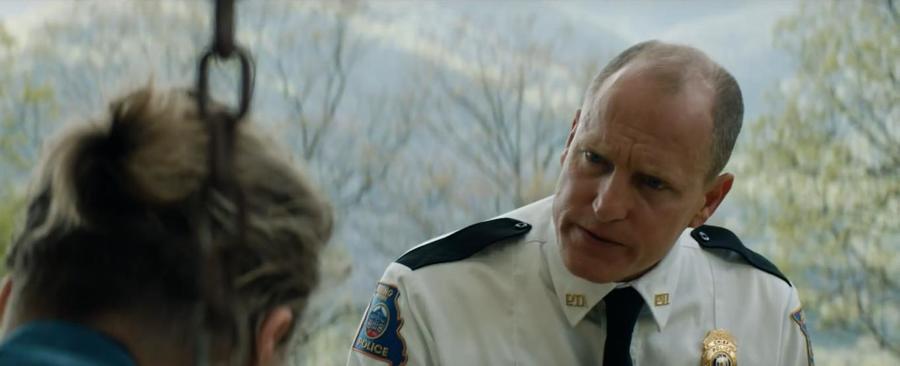
Willoughby gets his own section for the source of completeness, but there’s not really anything wrong with him. His unwavering faith in Dixon is inexplicable, but other than that he’s just the only main character who seems to be a relatively decent human being. He does initially attempt to strong-arm the ad agency, but when that fails he seems to settle down and try to address the problem with a mix of rationality and even good-natured humor.
I guess my only question about him would be why he’s in the film at all. If the film is trying to make a comment on police incompetence, why would it place the responsibility on the shoulders of a man who seems well-meaning and completely reasonable? When Willoughby confronts Mildred about the billboards, he seems genuinely pained by the fact that he’s been unable to solve the crime. But it’s outside of his control: if there are no leads, there are no leads. (Mildred suggests a few courses of action he could take, but they’re illegal and unethical.) If something bad happened to a friend or relation of mine, Willoughby is the kind of person I’d want on the case. He didn’t succeed in solving it yet, but he’s in it for the long game, convinced that in time something will turn up. The only flaw in his plan is that his own time is almost up… but we’ll get to that later on.
The Awful Setting
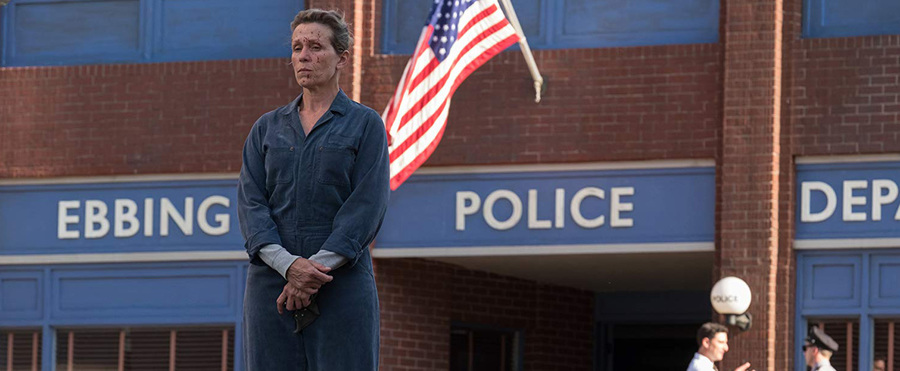
I watched a “making-of” featurette about the film, and at one point a crew member states that Ebbing itself is a “character” in the film. The idea of setting-as-character seems to have become a very popular concept in recent years (I don’t have the numbers on this, admittedly), but it’s a difficult thing to pull off. What it implies, basically, is that the setting is so richly-realized and distinctive, and its effect on the characters so profound, that it becomes an important part of the narrative in its own right. Ebbing, Missouri is not an example of this.
Three Billboards seems to want to be The Wire when it grows up. It wants to explore themes of racism and police mismanagement, it wants to be both serious and funny, and apparently it wants to do setting-as-character. But The Wire’s Baltimore is orders of magnitude more complex than Ebbing. Nearly every season has multiple plot threads that revolve around issues of infrastructure: how acres of abandoned row homes enable the criminal underground, or how vast real estate holdings are used to launder money. The spaces the characters inhabit are richly detailed, be they the home of the harbor cop or the mayor’s office. Each one is familiar and distinct, and says a lot about the people associated with it.
Ebbing has none of these qualities. There are a very small handful of settings, and none of them are particularly memorable. Mildred lives in a fairly ordinary house. It’s not fashionable, but it’s not a dump, either. Dixon lives in a very similar house. Willoughby lives in a somewhat nicer house and has a very ordinary barn out back. Mildred’s son goes to a completely nondescript school. The ad agency is an office. The police station is a police station. Other locations around town include The Dingy Bar and The Nice Restaurant. Even someone who loved this film isn’t going to be motivated to seek out these filming locations and visit them, because they’re not the least bit interesting.
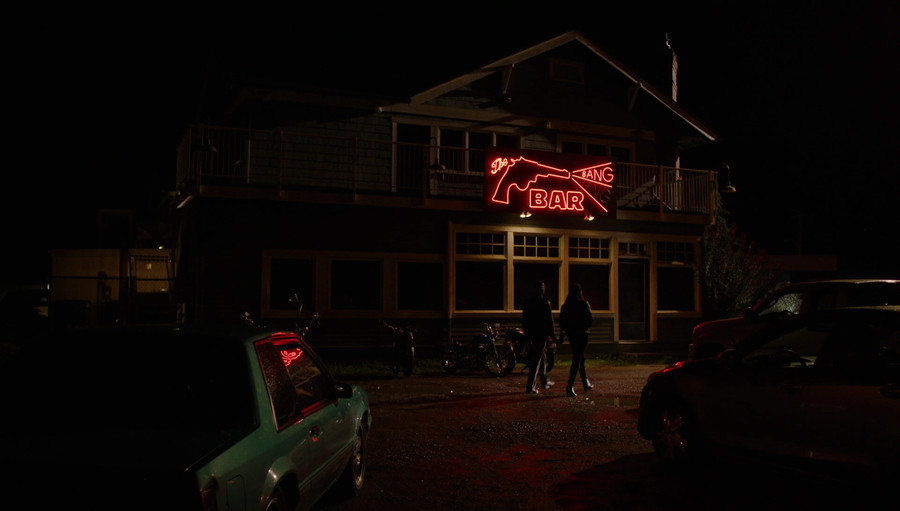
One very little thing that might have helped would be to see the outside of these locations more often. The interior of the Roadhouse in Twin Peaks is not particularly unusual, but when a scene is to be set there, there is usually an establishing shot of its facade, which is far more distinctive. The problem facing filmmakers is that buildings tend toward a kind of sameness inside. But outside, where they meet the chaos of the larger world, they take on a more distinct personality. In Three Billboards, the facade of the police station appears numerous times, and as such it probably comes closest to feeling like a real location, not just some contrived environment that looks like a thousand other places.
But my counterexamples are both television series with far more space to work with. Could it be that it’s simply not possible to make the setting be a character in the scope of a feature-length film? Of course not. Fargo. The Shining. Mulholland Drive. The Grand Budapest Hotel. Lost in Translation. Even Dogville, which manages to evoke a complex setting despite the fact that it’s mostly invisible.
The Awful Themes
You don’t need to tackle complex social issues to tell a good, engaging story. Most of the films I listed in the previous paragraph don’t try to offer up any critique of society. Fargo isn’t trying to say anything about crime, it’s just a story about some criminals. But, as stated before, Three Billboards aspires to be The Wire. It clearly wants to tackle some gritty problems head-on, ripping aside the curtain to reveal America’s ugly truths.
The problem is that Martin McDonagh is a British-Irish director who, so far as I can tell, usually lives in London. David Simon, co-creator of The Wire, has lived in Baltimore his entire life and began his career as an investigative journalist specializing in crime reporting. This is the kind of expertise one needs in order to write deep-cutting examinations of societal ills.
The issues that Three Billboards attempts to address are difficult problems that most lifelong American citizens have trouble understanding. The Wire spent five seasons exploring how government bureaucracy and organized crime feed into each other. Three Billboards wants to comment on numerous different themes, but at only two hours it can barely do anything other than mention them in passing, then move on.
Police Brutality and Racism

This is probably the most egregious of Three Billboards’s quixotic attempts to depict an ugly fact of American society. The brutalization of Black people by American law enforcement is one of the most high-profile problems in America today, and unfortunately it will probably take years to solve it. It’s a manifestation of the fraught racial conflict that America has carried in its blood for its entire existence.
So how does Three Billboards depict the issue? By mentioning it. It is implied that Dixon was involved in some sort of altercation with a Black citizen, possibly the “man in custody” who he tortured. Exact details are never given, but the incident appears to be well-known to the town’s citizens. Now remember: the movie chooses to depict Dixon as “a good man at heart.” Since we don’t know for sure whether Dixon actually brutalized a Black person, this means the film’s subtext is saying one of two things: a) Cops who are accused of brutality might actually be totally innocent, or b) Cops who brutalize people might be “good at heart.” I don’t see how either of those messages are productive in a society where Black people make up 31% of all police killings despite comprising only 13% of the population.
But it gets worse, because Three Billboards at one point attempts to play the issue for laughs. Mildred tries to get Dixon riled up by asking him “how’s the n____r-torturing business,” which causes Dixon to explode, insisting that she has to refer to it as “persons-of-color-torturing.” Not only does this trivialize the real-world problem of police brutality, it also makes the term “persons of color” into a punchline. I’m really not sure how this joke was supposed to work. Is it funny because Dixon, an apparent racist, is nonetheless dedicated to being “politically correct?” Is it funny because he’s more concerned about Mildred’s use of a racial slur than he is by his own history of racial violence? But more to the point: is it funny at all? I can’t say how this scene plays out to UK audiences, but as an American I can’t say I’m quite ready for a joke that hinges on two White Americans making light of systemic racism.
Finally, the film at times sees fit to imply that racism is no longer a problem in America–even that it’s specifically no longer a problem in the South! After Willoughby’s death, his replacement is a Black officer (played, incidentally, by The Wire’s Clarke Peters) who fires Dixon within minutes of his arrival. Dixon goes home to mope, and despite his alleged history of racism he doesn’t throw any slurs in the direction of the new boss. (Our hero Mildred is the only person to use the “n-word” in this film.) Dixon’s mother wants to go down to the police station herself to demand that Dixon get his job back and to “get rid of that Black guy.” Dixon says that won’t work: “Things [e.g., racial issues] have moved on in the South.”
Oh? This should be news for the NAACP, which in August of 2017 (mere months before the film’s release) issued a “travel advisory” urging African Americans to “pay special attention and exercise extreme caution” when passing through the state of Missouri. There were numerous factors that led to this unprecedented warning, including Missouri Senate Bill 43 (a law that made it more difficult to sue over discrimination) and the death of Tory Sanders, a mentally-ill Black man from Tenessee who ultimately died in police custody after getting lost in Missouri. Officers claim that he became violent, forcing them to use Tasers and pepper spray. Tory Sanders eventually died of cardiac arrest, likely the result of his mental illness compounded by the trauma. The White sheriff of the county, who led the charge into Sanders’s cell, has been cleared of charges of murder.
Rape
Dixon states, referring to The Suspect: “I know he’s done something.” And it’s hard to argue with that assessment. As we discussed earlier, The Suspect is one of the most transparently villainous characters ever put on the silver screen. We may not know specifically what he’s guilty of, but someone so obviously sinister must be up to no good. Three Billboards is a world where evildoers wear their credentials on their sleeves.
Such is not the case in the real world. While these crimes do happen, they are in the minority. 70% of rapes are committed by persons known to the victim, 25% by people with whom the victim has been in a relationship. Only 28% are committed by strangers. In the case of juvenile victims, the numbers are even more stark: only 7% of (reported) rapes of juveniles are committed by strangers.1 And factoring in homicide, only 0.4% of murders by strangers occurred in the circumstances of rape.2
I’m not trying to claim that rape-murders don’t happen, of course. My problem with the film’s handling of this issue is that it perpetuates the idea that all rapists are obvious boogeymen: you’ll know one if you see one. This is a dangerous lie. As the statistics reveal, it’s much more likely that a person will be raped by someone they considered a friend than by some evil lunatic who they’ve never met before. This is one of the reasons that rape is a notoriously underreported crime. Another is that victims often think of rape as a “personal matter” (13% of non-reporting victims) or something “not important enough to report” (8%).3 In fact, some victims don’t even realize that their experience qualifies as a rape. As stated by the National Institute on Alcohol Abuse and Alcoholism: ““[V]ictims may not realize that they have actually experienced legally defined rape or sexual assault, because the incident does not fit the prototypic scenario of ‘stranger rape.’’” Is not Hollywood largely to blame for creating and reinforcing this “prototypic scenario” to begin with? Is it not the responsibility of “serious” films to try to erode this idea, rather than continue to bolster it?
The Catholic Church

In one of the most obviously indulgent scenes of the film, Mildred receives a visit from a Catholic priest. The priest tells her that he and some members of his congregation are opposed to the billboards, and Mildred responds with a lengthy block of exposition, the gist of which is that she believes the Church as a whole is culpable for the many crimes committed by its clergy. Finally, something I actually agree with!
But… why is it in here? Outside of this scene the Church is never mentioned, and the priest never appears again. The Church played no role in Angela’s death, nor did it conspire to interfere with the investigation. As far as I can tell, McDonagh just wanted to take a stab at the Church, and while I can hardly blame him, he should have set that aside and next time made a movie about that. You can’t just stuff every timely issue into one film and expect to make intelligent commentary on all of them.
Cancer
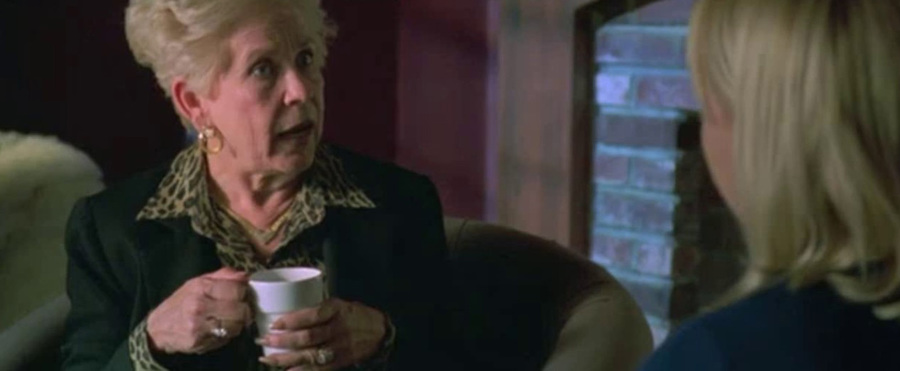
Ah, cancer. What would the hack writer do without it? It never needs explanation and depending on the needs of the plot it can range all the way from deadly to temporary inconvenience. And to top it all off, most of us already have emotional associations to it without the writer needing to do anything.
Three Billboards, like many stories before it, employs cancer as a very superficial plot device. It’s a cheap trick to make the audience sympathize more with Willoughby, and then to get him out of the way so that Dixon can begin his preordained reformation.
The proof that the film has nothing to say about cancer can be found in the fact that Willoughby could be killed by anything else and the script would hardly need to be changed at all: food poisoning, complications following a car accident, or an untreated infection could all have been employed instead. All the script needs is for Willoughby to see death approaching from aways off, and cancer is just the most “topical” way to do it.
Furthermore, the film’s depiction of cancer can’t even be bothered to be accurate. Despite being (supposedly) in the terminal stages of cancer, Willoughby is still going to work as usual, appears to have a completely normal amount of energy, and the only sign of illness is that he coughs up blood in one scene. According to the script, he has pancreatic cancer, the symptoms of which include jaundice, pain, nausea, and weight loss.4 Its symptoms do not include coughing up blood, which is the only symptom Willoughby ever manifests. As I said in my review of The Fault in Our Stars, the writer has failed to grasp the seemingly self-evident point that sick people are sick. You know how having a cold makes you feel really terrible? Cancer is worse than a cold.
And let’s not forget the fact that Willoughby is ultimately done in not by cancer, but by suicide. Now, cancer patients do experience a higher rate of suicide than the general population, so this is not inaccurate (though it is heavy on sentimentality). But there’s a more important factor in most suicides, including cancer-related suicides: depression, which is a factor in at least 50% of suicides. So why give Willoughby cancer at all? He has every reason in this situation to experience situational depression. He’s ineffective at his job, runs a squad made up of hooligans and idiots, and a respected member of the community has launched a public smear campaign against him. This film could have made a genuinely interesting portrayal of a character with depression instead of a superficial portrayal of cancer. And imagine how it would impact Mildred if she actually had Willoughby’s death on her conscience!
I opened with The Room because the depiction of cancer there is hardly any different than its depiction in Three Billboards. In both cases, cancer is named but not actually depicted. It’s a shortcut to making the audience feel something; rather than earning the viewer’s emotional response by building an interesting story, it just triggers an automatic emotional response by reminding the viewer of something sad. It’s no different from a commercial that uses a classic song to invoke nostalgia. This technique is cheap, tasteless, and has no place in serious narrative.
Vigilantism

As the film ends, Mildred and Dixon are on their way to (possibly) exact summary justice on The Suspect, closing out on the theme of vigilantism that was the story’s logical conclusion. As touched on already, Three Billboards is effectively a modern Western; Mildred’s quest for her daughter’s killer parallels that of the lone gunslinger lookin’ for the man what killed his Paw. Humans seem to be innately interested in the concept of vigilante justice, which in fiction stretches back at least as far as Robin Hood. It speaks to our desire to see evildoers punished in a world where they too often get off scot-free.
What concerns me about the vigilantism of Three Billboards is the fact that it’s depicted in a favorable light, even in spite of the fact that Mildred and Dixon have no concrete evidence that The Suspect is guilty of anything. What’s especially problematic about this is the way that it’s presented in the context of a story that claims to be realistic, and to hold up some sort of moral message. When Batman throws a hoodlum out of a window, the scenario is somewhat different, because Batman is an inherently unrealistic character. We can vicariously thrill to his exploits without the impression that his creators think that real life would be better off with Batman in it. But scenarios like the one depicted here actually do happen, and tend to have ugly consequences.
Recall the case of George Zimmerman, the neighborhood watch volunteer who in 2012 shot Trayvon Martin, igniting the eventual Black Lives Matter movement. “Neighborhood watch” organizations are meant to encourage citizens to act as eyes for the government police force, not to become involved in dealing justice themselves, but in some cases these “watchmen” have been known to begin taking their responsibilities more seriously, crossing the line into vigilantism. Such was clearly the case with Zimmerman, who, after phoning the police, decided to take his gun and follow Martin (in violation of the police dispatcher’s advice). “These assholes, they always get away,” Zimmerman said to the dispatcher, prior to the shooting. He did not trust the police to arrive on time, and decided to take matters into his own hands.
But Zimmerman has been on both ends of vigilante justice. In 2015, he was targeted by a man named Matthew Apperson, who was angry about Trayvon Martin’s killing and had decided that he needed to act as the hand of justice. Apperson attempted to shoot Zimmerman through his car window, and afterward claimed that he had acted in self-defense, just as Zimmerman had a few years before.
This is real-life vigilantism, and both cases amply demonstrate why this is not behavior that ought to be lionized. Certainly American law enforcement has a lot to answer for, but citizens should not take this as an excuse to begin visiting frontier justice on each other.
The way that Three Billboards depicts vigilantism is essentially irresponsible, painting a picture in which our “heroes” are justified in killing a man who has been cleared of wrongdoing by the legitimate justice system. Though The Suspect is undeniably a slimy bastard, there is no concrete evidence at all of any greater wrongdoing. Mildred and Dixon, on the other hand, have between them many counts of assault and criminal endangerment. This film’s warped understanding of social issues chooses to close on the thought that vigilantism is a defensible course of action, and in the fraught landscape of American politics, that could be the most irresponsible thing it does.
The Awful Structure
Maybe you want to forgive Three Billboards for its failure to be socially significant. Maybe you just want a good story, and are willing to overlook other shortcomings if it at least spins an enjoyable tale.
Unfortunately, Three Billboards can’t seem to clear that hurdle, either. While it was clearly enjoyable enough to a large number of theatergoers (currently it sits on a respectable 86% audience approval rating at Rotten Tomatoes), the narrative has a number of glaring flaws. To me, these are but mild annoyances compared to the issues I’ve already covered, but were they the film’s only flaws I would still find them difficult to ignore.
Absurd Coincidence
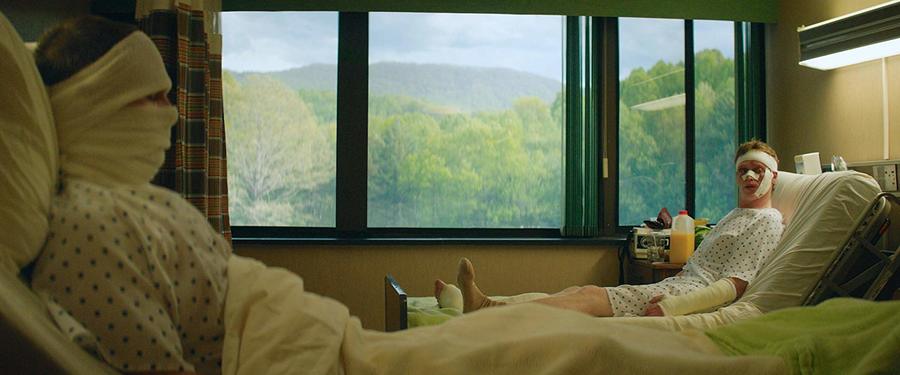
The most noticeable of these problems is the number of coincidences that crop up throughout the film’s run time. Some of these are critical to the functioning of the plot (though it could have been rewritten to eliminate them), while others seem completely gratuitous.
The most absurd example of these for me is the scene when the badly-burned Dixon is wheeled into his hospital room, only to discover that his roommate is none other than Red the ad agent, recuperating from the near-fatal beating that Dixon gave him a few scenes earlier. (I’m a bit fuzzy on the actual timeline of the film but this could be as recently as two days earlier.) The whole film we’ve been told that Ebbing is a small town where everyone knows everyone else’s business, and now we’re expected to believe that hospital staff would be so clueless as to put victim and victimizer in the same room?
Furthermore–what’s gained from the hospital scene? It gives Dixon an opportunity to show remorse, indicating that he’s changed, but his character reversal was already established when he risked his life to save the Angela Hayes casefile from the fire. It gives Red a chance to demonstrate that he’s the only decent human being in the film (he forgives Dixon and helps him drink some orange juice), but as an ancillary character he doesn’t really have an arc that needs to be concluded. I suppose it brings a bit of closure to Dixon’s most heinous act of the film, but showing that Red forgives him doesn’t mean the evil of his actions is now mitigated. If this was an attempt to rehabilitate Dixon, it’s too little, too late.
Another example: Mildred goes on a date with Peter Dinklage’s character, James (who I will not be discussing, because I have surprisingly little to say about him), and who should show up at the restaurant but ex-husband Charlie and the dim-witted Penelope. Charlie confesses that it was he who set the billboards on fire a few scenes earlier. The film then implies that Mildred is going to assault him with a wine bottle (and at this point, who would be surprised?), but then she just gives him the wine, admonishes him to treat Penelope with kindness, and the scene ends. I suspect this scene exists for the same reason the hospital scene exists: to tie up a character arc with a nice little bow so we can move on to our triumphant conclusion. The revelation that it was Charlie who set the fires is interesting, but doesn’t really mean a whole lot in the grand scheme of things, especially since he never appears again. Nothing substantial is gained by the contrivance of putting Mildred and Charlie in the same restaurant at the exact same time. You could remove Charlie from this scene entirely–hell, you could remove Charlie from the movie entirely–and the narrative would hardly change at all. He’s an extraneous component, and shoehorning him in via sheer coincidence hardly helps that.
So in a way, these coincidences are related to another problem that plagues the film, namely:
Useless Scenes and Characters
Three Billboards has a runtime of nearly two hours, but it could probably be cut down to less than 90 minutes if all the extraneous story elements were removed.
Here a few readers may be ready to jump in and object that a story would be cold and lifeless if it were stripped to its bare necessities. But this is not exactly true. Fiction is not a simulation of the messiness of real life, it is a carefully-constructed illusion of it. The best fiction is that which captures the feeling of disorder when in fact it is tightly controlled by the writer. (Again, look at The Wire for an example of this done well.)
Three Billboards is not tightly controlled, though. McDonagh is like a chef who tries to fix a recipe by adding more and more ingredients. This film is about two characters: Mildred and Dixon. But McDonagh wanted to make a sweeping epic in which every ancillary character gets a personal story arc, so we get the story of Willoughby, we get the story of Charlie, we get the story of Red, we get the story of Robert. This stuff doesn’t strengthen the core of the story, it distracts from it.
It gets worse. At least Charlie’s story is connected to Mildred’s, and is interesting in its own right. There are other scenes and characters that are even more disposable. The priest scene, which we’ve already discussed, is a prime example. It could be cut from the film and the narrative would be completely unaffected. But this isn’t the only scene that could be described thus.
Another prime example is the scene in which Red summons Mildred to the ad agency to tell her that due to a bookkeeping mistake, she owes him some money in order to keep the billboards up. Uh-oh! How will Mildred find the cash in time to save the day? Don’t worry, in literally the same scene, Red’s secretary comes in with an envelope full of money–an anonymous donor has paid the bill! (And again, jaw-dropping coincidence and unnecessary scenes go hand-in-hand here.) This scene is just astonishing to me for how useless it is. Why would anyone write a scene that introduces a conflict only to resolve it seconds later? Even when the Spider-Man newspaper comic pulled this stunt it had the decency to delay the resolution until the next day’s episode. Conflict is the drive behind most storytelling, sure, but that implies that the resolution of said conflict is deferred to a later scene. Putting conflict and resolution in the same scene is like combining matter and antimatter–they annihilate each other, leaving a void.
The Flashback Scene
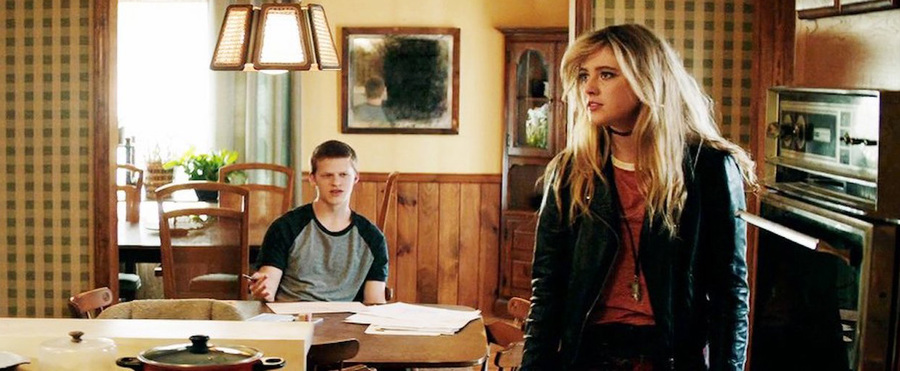
The trouble with flashbacks is that they break the narrative flow, and unless a story is specifically built around the use of flashbacks (Citizen Kane, for instance), they can be jarring and artificial. Care to guess how many flashbacks are in Three Billboards? That’s right: just one! This is a usually a bad sign (as it indicates that the scene is going to run counter to the direction of the rest of the story), and Three Billboards falls smack into the trap.
In the flashback scene, Mildred thinks back to the last time she saw Angela alive. (Angela is played by Kathryn Newton, who months earlier had appeared in HBO’s Big Little Lies, a series which I didn’t love but which nonetheless runs circles around Three Billboards.) Apparently, she and Angela got into a shouting match over whether Angela could borrow the car, and their fight ended with Angela saying “I hope I get raped!” to which Mildred replied “I hope you do too!”
I get what this scene was trying to do: it was supposed to show that Mildred feels that she was responsible for Angela’s death (as Angela might have lived if she’d been allowed to take the car), and that she feels intense remorse over the tragically ironic note that she and Angela parted on. But this whole scene just feels so deeply contrived and artificial, dialed to eleven with the most melodramatic and sentimental writing imaginable. It’s like a first draft that was supposed to be replaced with something better, or an amateurish story from an Intro to Creative Writing class. It’s embarrassing to watch, and the film would be stronger without it. Off the top of my head I can’t suggest how Mildred’s feelings of guilt should have been depicted–but literally, nothing would be better than this.
Ridiculously Explicit Foreshadowing

Finally, let’s talk for a minute about foreshadowing. The practice of including hints about things that will happen later in a narrative is probably the most well-known of all literary devices, easily understood by both children and adults. It’s an important component of all well-formed plots, and works both ways: every hint should have a payoff, and every plot twist should be presaged by a hint.
But foreshadowing is a decidedly artificial construct–real life does not work this way. So it’s important that foreshadowing be subtle, to avoid calling too much attention to itself. Really blatant foreshadowing is one of the surest ways to pull the audience out of the story, because it’s a reminder that the story is all a construct.
So, predictably: Three Billboards contains some of the most explicit foreshadowing I’ve ever seen.
In his letter to Dixon, Willoughby writes that eventually there will be a breakthrough in the Angela Hayes case. Someone will be overheard bragging in a bar, he predicts. Shortly later, after the fire-bombing incident, Dixon goes to a bar, where–no joke–he overhears The Suspect, bragging about committing rape and murder.
McDonagh appears to think that you, the audience member, are an idiot who will be unable to grasp the significance of this moment if it hadn’t been spelled out in exact terms just a few minutes earlier. Plus, it either represents another absurd coincidence in this film’s litany of absurd coincidences, or it means that Willoughby was an oracle.
Explicit foreshadowing can work in certain circumstances. The Princess Bride contains several examples of this principle at work. Inigo Montoya spells out his mission early on, to seek out the eleven-fingered man who killed his father and exact revenge. Inigo spells out exactly what he will do, right down to the prepared speech he will make. So when we see the eleven-fingered man on screen, we know exactly what will happen, and when it does, it’s both dramatic and funny.
David Lynch uses this technique as well. In Wild at Heart, Sailor Ripley pledges that he will sing “Love Me Tender” only to the woman he will marry. When he finally sings it to Lula at the film’s conclusion, it’s one of Lynch’s most genuinely emotional moments. In Mulholland Drive, Lynch uses explicit foreshadowing to cultivate suspense in a scene in which a character describes a creepy premonition he’s had. Moments later we’re forced to watch as his nightmare comes to pass, knowing exactly what’s going to happen but not knowing when. It’s incredibly effective.
What makes these examples work where Three Billboards does not? For one thing, none of these are intended to be taken as seriously as Three Billboards clearly wants to be. The Princess Bride is a goofy comedy spoof, and Lynch’s films are surreal dreamscapes. They can afford to strain credibility, because they were never trying to be credible in the first place. Furthermore, in the cases of Inigo Montoya and Sailor Ripley, these foreshadowings are driven by character, not by happenstance. Explicit foreshadowing can work in certain kinds of stories, and Three Billboards simply isn’t that kind of story.
Once again, this problem could be resolved by removing elements from the script without the need to add anything. Willoughby could promise that a break will arrive someday and simply not make the more-specific prediction about a braggart in a bar. Combine that with the fact that The Suspect has already been introduced in an earlier scene, and that’s all the foreshadowing you need. To be any more explicit than that is to disrespect the intelligence of the audience.
Conclusion
To write this absurdly long diatribe on Three Billboards Outside Ebbing, Missouri, I had to watch the film a second time, then spend several hours composing and revising. Why spend so much time on something that I already hated at the outset?
* Lorrie Moore did take the time to write about it though, and her take is well worth reading.
Firstly, because Three Billboards is bad in an interesting way. Its shortcomings lend themselves to discussion about the craft of fiction and/or film, and the treatment of social issues in Hollywood. I hated Blue is the Warmest Color too, but it’s unpleasant in a more bland and boring way.* A few weeks after I watched it I could hardly even remember what it was about; weeks after I first saw Three Billboards I was still thinking about the entire film in excruciating detail. I couldn’t not write about it. There was too much to say.
Secondly, any piece of fiction that falls on its face can be taken as an instructional case study for aspiring storytellers. If you understand why Dixon fails as a complex character, you can avoid making the same mistake when constructing your own characters. You can learn how to write social commentary, rather than a story that cheapens social issues by using them as window dressing. This essay isn’t a review so much as it is an autopsy. It is my hope that you will find some of these observations useful and apply them in your own work.
And so I close the book on Three Billboards. It has consumed far too much of my time over the last few weeks, and I’m eager to move on to more worthy causes. Let us speak of Three Billboards no further, and direct our strivings toward a world where all stories are good.
I don’t ever want to write something like this about a story of yours, dear reader. Don’t let me down.
Images are property of their respective owners.